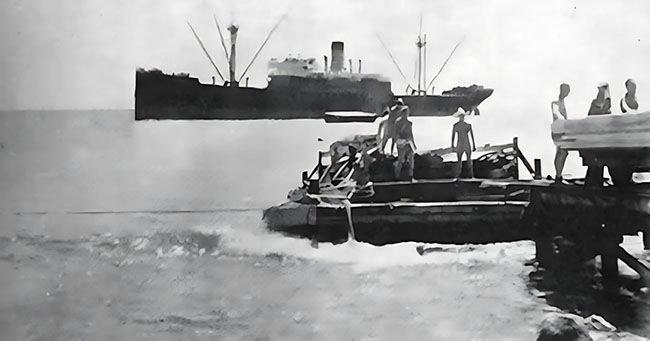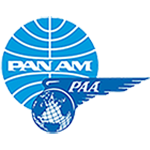MARCH 1935
"Endurance Tests" / "A Royal Airline"
"Endurance Tests"
From January through March of 1935, thirty endurance flights over the Caribbean in Pan Am's newly modified Sikorsky S-42 prepared Ed Musick and his crew for the long-range survey they would make across the Pacific in April of that year.
Excerpt from "PAA's Pacific Survey Flights by John L. Johnson, Jr. in "The Airpost Journal", April 1985 (used with permission).
Compilation: Ed Musick and Crew at Dinner Key before taking off for Acapulco March 27, 1935 (University of Miami Special Collections negative) and photo of Sikorsky S-42 (Pan Am Historical Foundation collection).
The first S-42 built, originally given number 4200-X -- but when later delivered to Pan Am, named the Brazilian Clipper and designated NC-822M -- was completed in March 1934. On April 26 and May 17 [1934] she established three international seaplane altitude records, and on August 1 added eight international seaplane speed records (See American Air Mail Catalogue, Fourth Edition, Vol. IV, U.S. Souvenir Historical Flights Section, Nos. 680, 682 and 686.3).
During these and other test flights it was determined that by stripping out some of the passenger accommodations and adding extra internal fuel tanks, the range of the S42 could be extended.
The second S-42 then under construction [later named Pan American Clipper] was modified in this manner and she emerged from the Sikorsky factory with a range of approximately 3,000 statute miles and an endurance of about 21.5 hours aloft. Nine 170-gallon fuel tanks had been installed within the aircraft cabin area, increasing her fuel capacity with 1,240 gallons in wing tanks to 2,770 gallons total. Oil capacity was also increased from 64 to 182 gallons. Fuel in cabin tanks was delivered to wing tanks by means of wind or hand driven pumps.
Sikorsky Aircraft applied for an "X" Iicense which was issued on October 24, 1934 and the X-823M was sold to Pan Am on December 19. The Bill of Sale was dated December 21, 1934 and the license changed to NC-823M on that date. Christened the Pan American Clipper, the NC-823M arrived at the Pan Am base in Miami on December 28.*
Training in the Caribbean
January-March 1935
After a thorough overhaul and servicing, the first test flight of 370 mlles was made on January 8, 1935.
The next day a flight of 485 miles over the Atlantic Ocean was flown. The crew normally consisted of
Capt. Edwin C. Musick, commanding;
Capt, R. O. D. Sullivan, first officer;
Harry R. Canaday, junior pilot;
Victor A Wright and Chauncey Wright, engineering officers;
William T. Jarboe, Jr., radio officer;
and Frederick J. Noonan, navigator.
Thirty Endurance Flights
10 Engineering Tests, 13 Over-Water Flight Procedure Tests & 7 Night Training Tests
A series of ocean going flights -- including ten classified as engineering tests, thirteen as crew training in long range over-water flight procedure and seven as night training -- was undertaken. Throughout these flights regular trans-ocean procedures were followed with various crew members standing regular watches with regular relief by other interchangeable crew members.
Sleeping quarters were provided and meals served during flights. In this series of extensive test and training flights every detail of long-range trans-ocean operations was followed and every crew member received training in every phase of not only his own work but also the duties of those officers whose functions were assigned to him during periods of relief.
Smooth Routine
Long-range over-ocean flying and navigation became a matter of smooth routine. Extensive data regarding the performance of the Pan American Clipper was recorded and digested by each crew member as well as the Pan Am engineerIng staff supervising actual preparations for transpacific flight.
The Final Caribbean Test
On March 22-23, 1935 a final non-stop test flight from Miami to St. Thomas, Virgin Islands and return was made: no problems were encountered.
Alameda, California
Preparing to Cross the Pacific Ocean
On March 1 Pan Am had applied for a "restricted" license to be used in conducting survey flights over the Pacific Ocean. The log of the Pan American Clipper dated March 24 reads: "Ship in hangar”.
On March 27** the NR-823M departed for the Pan Am base at Alameda, (on San Francisco Bay) via Acapulco, Mexico and San Diego. The crew consisted of the seven men listed above except for Chauncey Wright.
Upon her arrival at Alameda on March 31 she was given another thorough overhaul and servicing. Test flights were flown from Alameda on April 5, 9, 10 and 15.
NOTES
*United State Navy Department:

In response to interest from Admiral E. J. King, Chief of Bureau of Aeronautics, Navy Department in Washington, DC, Juan Trippe had made NC823M available to the US Navy Air Station observers in Anacostia, to both observe and perhaps co-pilot the plane during tests to be conducted and led by Ed Musick during the week of December 17-22, 1934 on its way down to Dinner Key in Miami (Letter from JTT, courtesy of Chelsea Jacks, Research, University of Miami Special Collections, “Testimony - J.T.Trippe S-42 Sikorsky Test Flight.” Box 0451, Pan American World Airways, Inc. records/ Photo U.S. Naval Air Station, Anacostia, Washington, D.C. 1932., Photo #NH 113003 courtesy of Naval History and Heritage Command).
**The SS North Haven:
 The very same day that Ed Musick and his crew left Dinner Key for California (March 27, 1935), a 6,700 ton ship chartered by Pan Am, departed for Honolulu from Alameda. Its name was the SS North Haven. Three boats and seven barges were loaded above deck, along with materials, food gasoline, launches, ops and maintenance equipment in the hold, for building Pan Am bases far beyond Honolulu. The expedition group included construction workers, managers, mechanics, radio operators, cooks, in addition to the crew of the ship. After an 8-day voyage to Honolulu and a three day stopover, the ship sailed the entire Pan Am expedition team (110 men) and all the Pan Am cargo to Midway to begin construction on the first base for Pan Am's survey flights across the Pacific. (Information from John Borger's "The North Haven Expedition", University of Miami Special Collections, Pan American World Airways, Inc. records).
The very same day that Ed Musick and his crew left Dinner Key for California (March 27, 1935), a 6,700 ton ship chartered by Pan Am, departed for Honolulu from Alameda. Its name was the SS North Haven. Three boats and seven barges were loaded above deck, along with materials, food gasoline, launches, ops and maintenance equipment in the hold, for building Pan Am bases far beyond Honolulu. The expedition group included construction workers, managers, mechanics, radio operators, cooks, in addition to the crew of the ship. After an 8-day voyage to Honolulu and a three day stopover, the ship sailed the entire Pan Am expedition team (110 men) and all the Pan Am cargo to Midway to begin construction on the first base for Pan Am's survey flights across the Pacific. (Information from John Borger's "The North Haven Expedition", University of Miami Special Collections, Pan American World Airways, Inc. records).
"A Royal Airline"
by Eric H. Hobson, Ph.D. & Pan Am Historical Foundation
Despite the Great Depression, by 1935 Pan American Airways had developed its operations across the Caribbean islands. But commercial flying was still considered novel and adventurous. News coverage featured a duo of particularly high-profile passengers who took PAA flights around the Caribbean on Commodore flying boats and the Sikorsky S-42 "Brazilian Clipper", brand new to the airline's fleet. They were the Duke and Duchess of Kent on their honeymoon, accompanied by the Duke's equerry, a Scotland Yard security man, one maid and two valets.

Photo of the Duke and Duchess in 1935. Pan American Air Ways, 6.2 (Feb./Mar./Apr. 1935) p. 3 (PAHF Collection).
“The British Royal Airline,” was a slogan Pan American Airways System could have touted in Spring 1935, highlighting it as “Your Tropical Honeymoon”.
Between February 13 and March 27, 1935 PAA transported the Duke and Duchess of Kent (Prince Edward of Britain and Princess Marina of Greece and The Netherlands) and entourage —a.k.a., “Mr. Grace and party” — on five Caribbean flights.
Pan American Airways-Undated (c. 1935) USA-Caribbean/South America Timetable (From the collection of Randy Liebermann) https://www.timetableimages.com/ttimages/pa.htm
The Kents sailed from England to Trinidad aboard the "Duchess of Richmond" and spent two weeks before heading to Jamaica, Wednesday, February 13, aboard Consolidated Commodore NC660M, adding six passengers and 800 pounds of luggage to Capt. Charles Lorber’s center-of-gravity calculations. They went on to Puerto Rico where they were honored by a squadron of US Marine Corps. aircraft escorting the Pan Am plane to its landing. The flight arrived 90 minutes late, likely due to the unscheduled stop made at Antigua to accommodate the Duke's request for a glass of punch.
After overnighting in San Juan, Puerto Rico, they continued Thursday (Valentine’s Day) to Port au Prince, Haiti, where they spent two nights.
Midmorning, Saturday, Feb. 16, the Royals boarded PAA’s scheduled San Juan-Miami northbound flight on the Sikorsky S-42, Brazilian Clipper (NC822M). Leaving Port au Prince, the plane diverted west to drop the “Grace party” at Kingston, before completing its Neuvitas, Cuba stop and ending the day in Miami well behind posted scheduled.
One month later, Gustave “Slim” Eckstrom brought chartered Consolidated Commodore NC699M from Miami to Kingston to ferry the royals to Nassau, The Bahamas the next day, Friday, March 15.
The romantic image of the Duke and Duchess of Kent -- island-hopping on Pan Am flights during their honeymoon -- no doubt boosted interest in the possibilities of Pan Am air travel around the Caribbean.
Sources:
“Duke and Duchess of Kent are now at Nassau in The Bahamas,” The Daily Gleaner (Kingston, Jamaica) Saturday, March 16, 1935, p. 1 & 3.
“Pan American Trips Taken by Royal Couple” Pan American Air Ways 6.2 (Feb./Mar./Apr. 1935), p. 3.
“Puerto Rico Hails Duke and Duchess”, New York Times, February 14, 1935, p. 23.
“Royal Newlyweds on W.I. Tour Given Big Welcome in San Juan,” The Daily Gleaner (Kingston, Jamaica) Friday, February 15, 1935, p. 1.
Time tables, passenger tariffs: Havana, Nassau, Mexico, West Indies, Central and South America, Alaska, China, December 1, 1934. Pan American Airways System, 1934.



